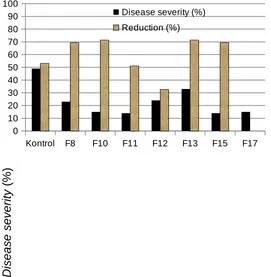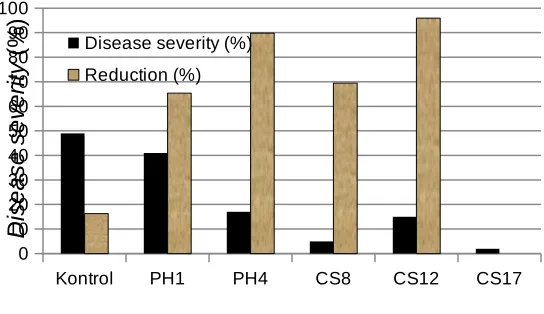Nature of Protection of Chilli Seedling from Rhizoctonia Damping-off by Plant Growth Promotion Fungi 1)
A. Muslim
Department of Plant Pests and Diseases;
Program Study of Agroecotechnology Faculty of Agriculture,
and Program study of crop science, Graduated School, Sriwijaya University Address: Jl. Raya Palembang-Prabumulih, Km.32, Inderalaya, Ogan Ilir
Sumatera Selatan kode Pos 30662. Telp/fax. 0711-580059/ Mobile:: 081367769589
e-mail : [email protected]
ABSTRACT
Protection of chili seedlings from Rhizoctonia damping-off by Plant Growth Promotion Fungi (PGPF) i.e.: Penicillium, Fusarium, Phoma, and sterile fungi was investigated in laboratory and greenhouse studies. The PGPF failed to show antagonistic interaction when grown in dual culture on agar media with Rhizoctonia solani.causing damping-off disease. All PGPF isolates did not inhibit the growth of
Rhizoctonia solani. Treatment of chili seedlings with PGPF for 10 days and then the treated chili roots were surface sterilized with 70% ethanol for 30 sec. When the treated seedlings were replanted and subsequently inoculated with pathogen, however, the protective capability against R. solani was still maintained. . Seedlings treated with Penicillium, Fusarium, Phoma, and sterile fungi reduced disease severity ranged from 30.0-95.9%; 32.6-71.4%; 16.3-65.3%; 69.4-95.9%, respectively. These results suggest that the mechanism of protection in this system might be induced resistance.
Key words: Biocontrol, Plant Growth Promotion Fungi, Rhizoctonia damping-off; Chili
INTRODUCTION
Damping-off seedling caused by Rhizoctonia solani Kuhn (teleomorp=
Thanatephorus) is economically important due to substantial losses it caused to farmers. Rhizoctonia diseases occur throughout the world. They cause losses on almost all vegetables and flowers. Very young seedling may be killed before or soon after they emerge from the soil (Agrios, 2000). Moulani (2005) reported that percentage of pre-emergence damping-off, pre-emergence damping-off and disease severity was ranged from 1-35%; 12,6-51,0%; 10.9-47.8%, respectively.
1) Disampaikan pada:International Seminar and The 21st National Congress of Indonesian
Conventional methods of control for R. Solani include cultural practices and fungicidal treatment. Frisina and Benson (1988). However, with changing farming methods (e.g. reduced till, direct drill and reduced crop rotation), increased concern regarding the effect of synthetic pesticides in the environment and the development of fungicide resistance in pathogenic strains prompted to farmers to choose alternative disease control management strategies. One such method involves biological control by the introduction of selected microorganisms to the soil (Campbell, 1989).
A Variety of soil microorganisms have demonstrated their potential as biocontrol agents against various diseases. Hyakumachi (1994) and Shivana et al (1996) reported that sterile fungi, Phoma, Trichoderma, Fusarium and Penicillium
effectively reduced damping-off diseases and Fusarium wilt of cucumber and also take-all disease of wheat.
The objectives of this research were: 1) to know the ability of PGPF
Penicillium, Fusarium, Phoma, and sterile fungi against the growth Rhizoctonia solani and their interaction on agar. 2) to evaluate the effectiveness of seedling treated with PGPF Penicillium, Fusarium, Phoma, and sterile fungi in suppressing Rhizoctonia damping-off after sterilizing the treated roots with 70% ethanol for 30 sec.
MATERIALS AND METHODS Fungi
Biocontrol agent used in this study was Penicillium, Fusarium, Phoma, and sterile fungi indicated as the Plant Growth Promoting Fungi (PGPF). These isolates were isolated from rhizosphere of chilli cultivated in low land area. Rhizoctonia solani Kuhn was obtained from an infected chili plant was used as the pathogen.
Plant
All chilli seeds were surface-sterilized with 1% hydrochloric acid for 15 min and rinsed three times in sterile distilled water before sowing.
Inoculums Preparation
cultured on potato dextrose agar (PDA) for 7 days at room temperature. Five mycelial disks (5 mm) of the isolates cut from the edges of three-day old cultures were added to 100 g moist autoclaved combinations of various substrates (1:1, dry various substrates/distilled water, w/v) contained in a 500 ml Erlenmeyer flask. The combination substrates used in this study was bran+corn+rice-straw with comparison 4 : 3 : 1 for each material, respectively. The cultures were incubated in room temperature for 10 days and shaken regularly to aid even colonization. The infested media substrates were air-dried for 7 days and stored at 4oC until used.
Assay of colony interaction between PGPF and Rhizoctonia solani
The influence of PGPF Penicillium, Fusarium, Phoma, and sterile fungi against R. solani in culture was examined by inoculating paired combination between PGPF and R. solani, 3 cm apart on potato dextrose agar (PDA) in three replicate 9 cm petri dishes. Interactions were assessed using a key based on the observations of Skidmore and Dickinson (1976). They recognized five separate modes if interaction colony growth: A) Mutually intermingling growth where both fungi grew into one another without any macroscopic signs of interaction (score 1); Bi) Intermingling growth where the fungus being observed is growing into the opposed fungus either above or below or above and below its colony, and its corollary (score 2); Bii) intermingling growth where the fungus under observation has ceased growth and is being overgrown by another colony (score 3); C) Slight inhibition where the fungi approached each other until almost in contact and a narrow demarcation line, c. 1-2 mm, between the two colonies was clearly visible (score 4); D) Mutual inhibition at a distance of > 2 mm (score 5). The percentage of inhibition against R. solani by PGPF also was recorded by formula: R1-R2/R1 x 100%, R1= the mycelial growth of R. solani in the position to the edge of petri dish and R2= the mycelia growth of R. solani in the opposed of PGPF isolates.
Assay of PGPF treatment in suppressing disease severity of Rhizoctonia damping-off
PGPF Penicillium, Fusarium, Phoma, and sterile fungi tested in the concentration 2% in plastic tray for 14 days. The treated seedling was then gently take away from soil. The treated root with PGPF was sterilized with 70% ethanol for 30 sec. The sterilized root of treated seedling were transferred to small plastic pot which filled with infested potting soil with pathogen R. solani in the concentration 1%. The seedlings not treated with PGPF and challenged with R. solani were set up as control. Treatments were replicated 4 times and each replicate consists of 5 plants.
Disease severity based on the damping-off or root lesion was assessed using a scale of 0 to 5; 0 = healthy; 1 = one or two light brown lesion (1mm) on the crown root; 2 = light brown-dark brown lesion 2-10 mm on root; 3 = dark brown lesion 10-25 mm ; 4 = dark lesion ≥ 26 mm water soaked of the hypocotyls; 5= collapsed hypocotyls with wilted leaves or dead seedlings. The percentage of disease severity in each replication within the treatment were calculated using the formula :
K=
∑
(nxv)ZxN x100
Where::
K = Disease Severity (%)
n = number of seedlings infected by pathogen in each scale v = Diseases scale (0-5)
Z = The highest of disease scale N = total seedlings
RESULTS AND DISCUSSION
All of the interaction observed between PGPF Penicillium, Fusarium, Phoma, and sterile fungi against R. solani in the score 1 or 2, which mean that Mutually intermingling growth where both fungi grew into one another without any macroscopic signs of interaction for score 1 and for score 2 is Intermingling growth where the fungus being observed is growing into the opposed fungus either above or below or above and below its colony, and its corollary (Skidmore and Dickinson, 1976). We did not observed any inhibition effect against R. solani by PGPF
Penicillium, Fusarium, Phoma, and sterile fungi. This results indicated that there are no antagonistic mechanism such as antibiosis or mycoparasite occur this study.
severity caused by Rhizoctonia damping-off of chilli. Seedlings treated with
Kontrol P1 P2 P3 P8 P11
Figure 1. The effect of treatment with Penicillium spp. in supressing disease severity of Rhizoctonia damping-off of chili caused by Rhizoctonia solani Kuhn
Kontrol F8 F10 F11 F12 F13 F15 F17 0
Kontrol PH1 PH4 CS8 CS12 CS17 caused by Rhizoctonia solani Kuhn
CONCLUSION
Agrios, George N. (2000). Plant pathology. Fouth Edition. Harcourt Asia PTE LTD. Academic Press. 635p
Campbell, R. (1989). Biological Control of Microbial Plant Pathogens. Cambridge University Press, Cambridge. 40p.
Cardoso, J.E. and Echandi, E (1987). Nature of protection of bean seedlings from Rhizoctonia root rot by a binucleate Rhizoctonia-like fungus. Phytopathology 77: 1548-1551
De Cal, A., Garcia-Lepe, R. and Melgarejo, P. (2000). Induced resistance by Penicil-lium oxalicum against Fusarium oxysporum f. sp. lycopersici: Histological stud-ies of infected and induced tomato stems. Phytopathology 90: 260-268.
Frisina, T.A. and Benson, D.M. (1988). Sensitivity of binucleate Rhizoctonia spp and R. solani to selected fungicides in vitro and in azalea under greenhouse conditions. Plant Disease 72:303-306
Hyakumachi, M. (1994). Plant-growth-promoting fungi from turfgrass rhizosphere po-tential for disease suppression. Soil Microorganisms 44:53-68.
Koike, N., Hyakumachi, M., Kageyama, K., Tsuyumu, s., Doke, N. (2001). Induction of systemic resistance in cucumber against several diseases by plant growth-promoting fungi: lignification and superoxide generation. European Journal of Plant Pathology 107:523-533.
Maulani, I. (2005). The percentage of disease incidence of damping-off on Chilli in Inderalaya Sub-District, Ogan Ilir District. Field Practice. Faculty of Agriculture, Sriwijaya University (Unpublished)
Merra, M.S., Shivanna, M.B., Kageyama, K., Hyakumachi, M. (1994). Plant growth-promoting fungi from zoyusiagrass rhizosophere as potential inducer of sys-temic resistance in cucumbers. Phytopathology 84:1399-1406.
Merra, M.S. (1994). Induction of systemic resistance in cucumber agains anthrac-nose using plant growth promoting fungi. The United Graduate School of Agri-cultural Science, Gifu University. Doctor Dissertation
Shivanna, M.B., Merra, M.S. and Hyakumachi, M. (1996). role of root colonization ability of plant growth promoting fungi in the suppressionof take all and com-mon root rot of wheat. Crop Proection 15: 497-504.

